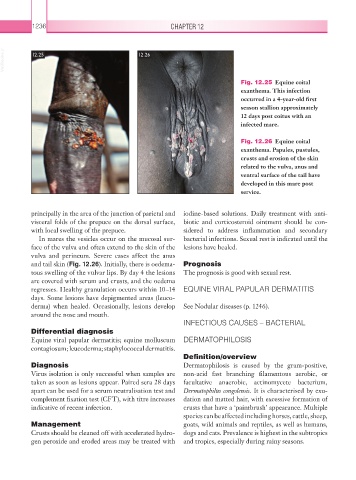Page 1261 - Equine Clinical Medicine, Surgery and Reproduction, 2nd Edition
P. 1261
1236 CHAPTER 12
VetBooks.ir 12.25 12.26
Fig. 12.25 Equine coital
exanthema. This infection
occurred in a 4-year-old first
season stallion approximately
12 days post coitus with an
infected mare.
Fig. 12.26 Equine coital
exanthema. Papules, pustules,
crusts and erosion of the skin
related to the vulva, anus and
ventral surface of the tail have
developed in this mare post
service.
principally in the area of the junction of parietal and iodine-based solutions. Daily treatment with anti-
visceral folds of the prepuce on the dorsal surface, biotic and corticosteroid ointment should be con-
with local swelling of the prepuce. sidered to address inflammation and secondary
In mares the vesicles occur on the mucosal sur- bacterial infections. Sexual rest is indicated until the
face of the vulva and often extend to the skin of the lesions have healed.
vulva and perineum. Severe cases affect the anus
and tail skin (Fig. 12.26). Initially, there is oedema- Prognosis
tous swelling of the vulvar lips. By day 4 the lesions The prognosis is good with sexual rest.
are covered with serum and crusts, and the oedema
regresses. Healthy granulation occurs within 10–14 EQUINE VIRAL PAPULAR DERMATITIS
days. Some lesions have depigmented areas (leuco-
derma) when healed. Occasionally, lesions develop See Nodular diseases (p. 1246).
around the nose and mouth.
INFECTIOUS CAUSES – BACTERIAL
Differential diagnosis
Equine viral papular dermatitis; equine molluscum DERMATOPHILOSIS
contagiosum; leucoderma; staphylococcal dermatitis.
Definition/overview
Diagnosis Dermatophilosis is caused by the gram-positive,
Virus isolation is only successful when samples are non-acid fast branching filamentous aerobic, or
taken as soon as lesions appear. Paired sera 28 days facultative anaerobic, actinomycete bacterium,
apart can be used for a serum neutralisation test and Dermatophilus congolensis. It is characterised by exu-
complement fixation test (CFT), with titre increases dation and matted hair, with excessive formation of
indicative of recent infection. crusts that have a ‘paintbrush’ appearance. Multiple
species can be affected including horses, cattle, sheep,
Management goats, wild animals and reptiles, as well as humans,
Crusts should be cleaned off with accelerated hydro- dogs and cats. Prevalence is highest in the subtropics
gen peroxide and eroded areas may be treated with and tropics, especially during rainy seasons.

